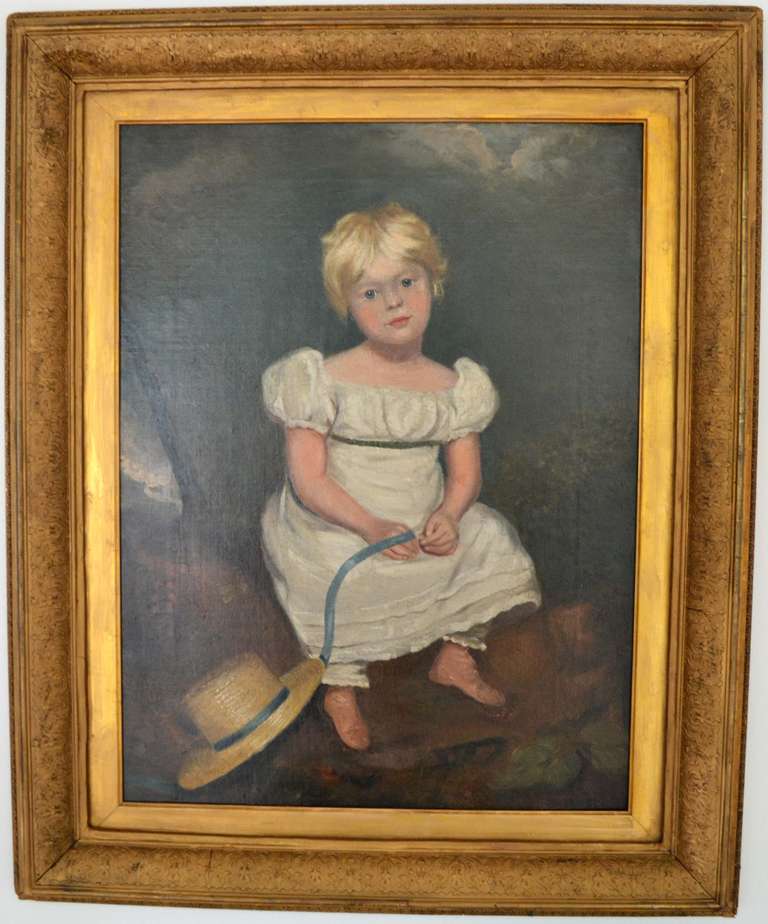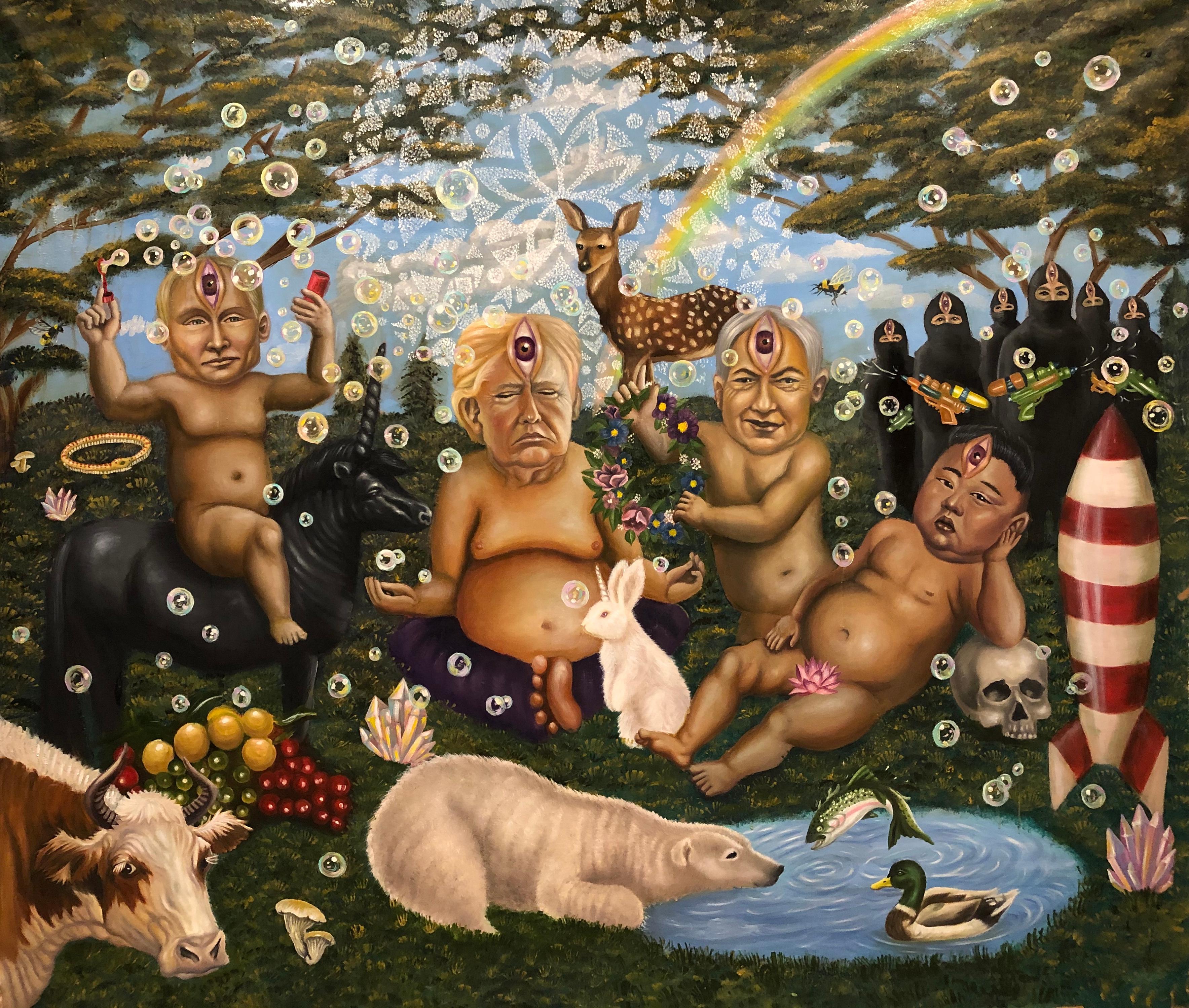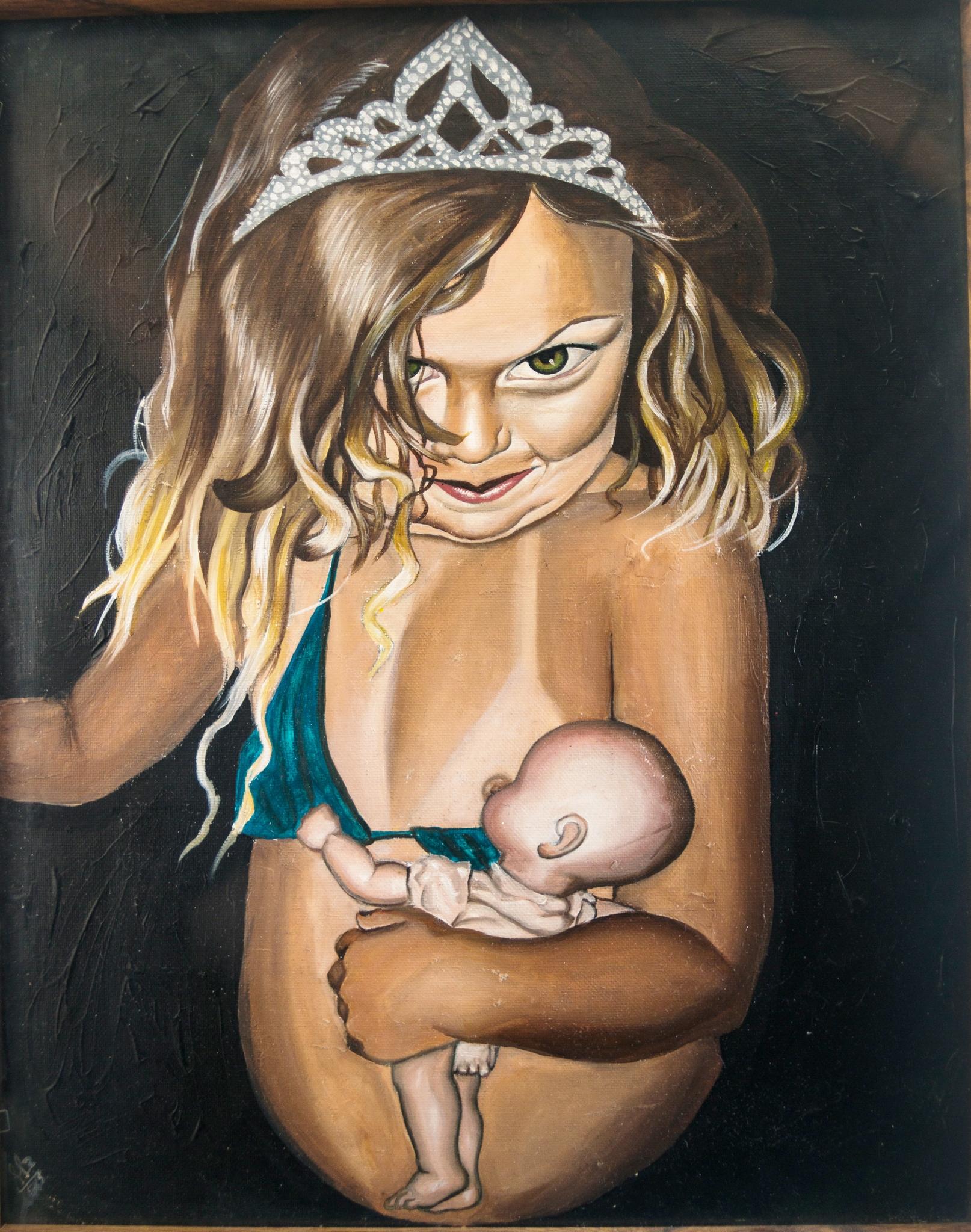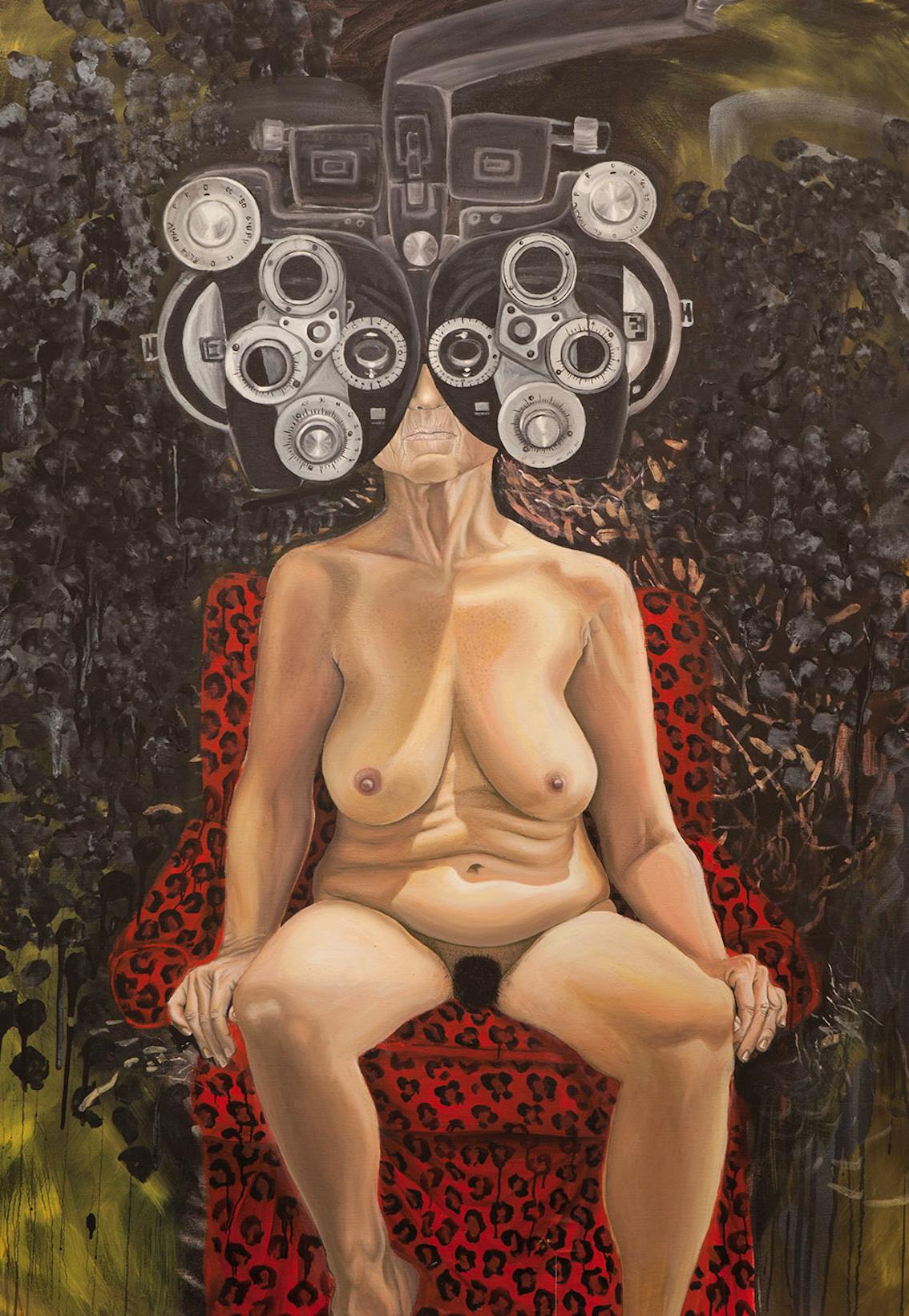Items Similar to Grand-Scale Old Master Garland Portrait, 17th Century, Signed & Dated, Rare work
Want more images or videos?
Request additional images or videos from the seller
1 of 12
Jan Anton van der BarenGrand-Scale Old Master Garland Portrait, 17th Century, Signed & Dated, Rare work17th Century
17th Century
About the Item
Indistinctly signed and dated
In the first quarter of the 17th century a new form of flower painting was developed in Flemish painting, which, recreated by a large group of artists and workshops, would achieve considerable success throughout the century in much of Europe: the garland of flowers surrounding a central figure. Brueghel de Velurs was the initiator of this type of composition, however, it was his pupil, Daniel Seghers, who was the dominant figure in this specialised production and the creator of a prototype that would serve as a model for the numerous artists who followed in his wake. It seems undeniable that the artist of the present painting had seen the Garlands of Flowers Surrounding a Medallion Depicting the Triumph of Love by Daniel Seghers and Domenico Zampieri (now in the Musée du Louvre in Paris).
In our painting, the present floral wreath encircles a carved cartouche within which sits Saint Dorothy of Caesarea and the attribute which often accompanies her in art, a basket of roses. The extremely delicate flowers have been rendered in meticulous detail, so that every species can be identified from exotic tulips to roses, irises and forget-me-nots; this obvious attention to naturalism is inherited from the Flemish manner. Each flower is so precise and refined that they are an individual study in their own right.
The still-lifes are from the hand of Jan Anton van den Baren, with the central figures by another accomplished hand. Van den Baren’s arrangement of flowers would have delighted connoisseurs in both Flanders and in Vienna, where the impossibility of their all blooming at the same time of year would have been understood as a further statement of the wonder and beauty of the divine.
Van den Baren worked first in Brussels, where he collaborated with Erasmus Quellinus II for the figures in his works, before moving with Archduke Leopold Wilhelm, his patron, to Vienna in 1656, where he instead worked with fellow Flemish émigré painter Nikolaus van Hoy. The iconography relates to an eighth century legend where she was presented a basket of roses by a child.
In addition to the brilliance of his handling of still-lifes Van den Baren played an important art historical role as Director of Archduke Leopold Wilhelm’s Picture Gallery in Vienna, then one of the greatest collections in the world and the core of what was to become the present collection of the Kunsthistorisches Museum, Vienna. Van der Baren compiled an inventory of the collection in 1659, and his predecessor as Director of the Archduke’s Picture Gallery (when it was still housed in Flanders), David Teniers, depicted van der Baren (third from right) in his celebrated Archduke Leopold Willem in his gallery at Brussels, conserved at the Kunsthistorisches Museum.
It is a shining example of the Flemish Baroque and is a very rare object indeed, considering there are only 14 paintings accepted as authentic works by this artist.
We are grateful to Fred Meijer for confirming the attribution to Johannes Antonius van der Baren.
A feature of this painting is its outstanding carved and gilded frame with a plethora of flowers and foliage.
Titan Fine Art
- Creator:Jan Anton van der Baren (1615 - 1686, Flemish)
- Creation Year:17th Century
- Dimensions:Height: 59.85 in (152 cm)Width: 51.19 in (130 cm)Depth: 3.94 in (10 cm)
- Medium:
- Movement & Style:
- Period:
- Condition:This painting has passed a strict quality and condition assessment by a professional conservator prior to going on sale. It can be hung and enjoyed immediately.
- Gallery Location:London, GB
- Reference Number:1stDibs: LU1199110971212
About the Seller
5.0
Vetted Seller
These experienced sellers undergo a comprehensive evaluation by our team of in-house experts.
Established in 1998
1stDibs seller since 2019
31 sales on 1stDibs
Typical response time: 1 hour
- ShippingRetrieving quote...Ships From: London, United Kingdom
- Return PolicyA return for this item may be initiated within 14 days of delivery.
More From This SellerView All
- Portrait of Young Gentleman, Lord George Douglas, Arcadian Landscape c.1710Located in London, GBPortrait of Young Gentleman, Lord George Douglas, in an Arcadian Landscape c.1710 Attributed to Charles D'Agar (1669-1723) Depicted with bow in hand and situated against an Arcadian...Category
18th Century Old Masters Portrait Paintings
MaterialsCanvas, Oil
- Portrait of an Elegant Lady in a Red Silk Dress, Beautiful Antique Frame c.1720By Jonathan Richardson the ElderLocated in London, GBThis beautiful portrait was painted circa 1725 and is a fine example of the English eighteenth century portrait style. The artist has chosen to depict the lady against a plain background wearing a simple red silk dress and transparent headdress hanging down the back. The sitter is not shown with jewellery or any other elements to distract the viewer’s attached, thus highlighting the beauty of the young sitter. This restrained manner achieves a sense of understated elegance. The portrait genre was valued particularly highly in English society. Neither landscapes nor allegorical pictures were ever priced so highly at exhibitions and in the trade as depictions of people, from the highest aristocracy to scholars, writers, poets and statesmen. With the rich colouring and lyrical characterisation, these works are representative of the archetypal English portrait and is are very appealing examples of British portraiture...Category
18th Century Old Masters Portrait Paintings
MaterialsCanvas, Oil
- Portrait of Lady Anne Tipping née Cheke c.1705, English Aristocratic CollectionBy Kneller GodfreyLocated in London, GBTitan Fine Art present this exquisite portrait, that formed part of a historic collection of an English aristocratic family, Lord and Lady Sandys at their magnificent baroque and Reg...Category
18th Century Old Masters Portrait Paintings
MaterialsCanvas, Oil
- Portrait of a Gentleman in Armour and Mauve Cloak c.1740; Louis Tocque, PaintingLocated in London, GBThe sitter in this superb portrait, presented by Titan Fine Art, is shown with the grandiloquence characteristic of the eighteenth-century French school of painting. The young nobleman has been portrayed wearing an ingeniously embellished French ceremonial armour, a mauve cloak, and an abundance of cascading curls falling below his shoulders. Our portrait proclaims to every onlooker that this is a superior being. The manner in which portraits were painted was set out by the terms of the commission and usually marked significant life events such as a betrothal, a death, elevation of rank… but they almost always emphasised the wealth and importance of the sitter. This type of portrait had become a standard format for aristocratic portraiture in Europe during the last quarter of the seventeenth century up to the middle of eighteenth century. Incorporated into the background was often a raging battlefield or a military encampment; our portrait is free from these trappings and contains a dramatic moody sky ensures the viewer focuses mainly on the subject. The features of the sitter’s face have been captured with great sensitivity, his confident gaze perhaps reflecting the near invincibility afforded by this steel suit. The flamboyance and penetrating sense of character, lending an air of noble expectancy to the composition, seems almost eclipsed by the artist's virtuosic handling of paint. It is not hard to understand why many wealthy sitters commissioned the artist to paint their portraits. Such fine and ornate armour was not actually used on a battlefield and thus its portrayal in portraiture was largely symbolic of a sitter’s wealth and status as well as a claim of succession to a chivalrous tradition. The style of hair and neckcloth were fashionable circa 1740. Held in an exquisite eighteenth century carved and gilded frame - a fine work of art in itself. Louis Tocqué was a very successful French portrait painter active during the Rococo period of art. His work was known for its attention to detail, its portrayal of the character of the sitter, the refined postures, and the delicacy of the rendered draperies. He created both realistic and expressive portraits. Tocqué was born in Paris in 1696 and trained with the famous portrait painters Hyacinthe Rigaud, Nicolas Bertin, and Jean Marc Nattier whose daughter he later married. He entered the Academy in 1731 and became a full member in 1734 with his portraits of Galloche and the sculptor Jean Louis Lemoine, and he pursued a brilliant career as a portrait painter, receiving numerous commissions from members of the French aristocracy and royalty. His works were highly sought after by collectors of the time, and his reputation earned him the appointment of official portrait painter to the court of France in 1746 – in fact he stayed at most of the courts in northern Europe. From 1737 to 1759 he exhibited a large number of works at the Salon. Tocqué's paintings can be found in museums and private collections around the world. Recent sales...Category
18th Century Old Masters Portrait Paintings
MaterialsCanvas, Oil
- Portrait Painting of Lady Mary Capel, Countess of Essex in a Yellow Dress c.1698By Sir Godfrey KnellerLocated in London, GBThis portrait depicts an elegant, aristocratic women wearing a yellow silk dress with white chemise and a red mantle elegantly draped around her body. By tradition the portrait represents Mary Capel, Countess of Essex. Born Lady Mary Bentinck in 1679, she was the daughter of William Bentinck, 1st Earl of Portland, a Dutch and English nobleman who became in an early stage the favourite of stadtholder William, Prince of Orange (the future King of England) and his wife Anne Villiers (died 1688). Lady Mary's maternal grandparents were Sir Edward Villiers and Lady Frances Howard...Category
17th Century Old Masters Portrait Paintings
MaterialsCanvas, Oil
- Portrait of Gentleman in Lace Cravat & Armour 1680’s Painting, Fine Carved FrameBy (circle of) Pierre MignardLocated in London, GBTitan Fine Art presents this portrait of a brave and chivalrous character. The gentleman has been depicted in armour, an elaborate full wig, and in accordance with the latest French fashion, an elaborate type of Venetian Gros point lace cravat and large silk bow (also called a cravat-string) – a type that were popular across Europe in the 1680’s. Point lace was fabulously expensive - a cravat was equivalent to six weeks income for a gentleman - and therefore indicative of a wearer's wealth and social class. A nobleman riding onto the battlefield would wear a lace cravat over his armour to demonstrate his status. The attire, along with the coat-of-arms, help to proclaim to every onlooker that the gentleman is a superior being. The depiction of the lace, apart from denoting the wealth of the sitter, was a deliberate way for the artist to demonstrate his own artistic ambition and technical skills Argent seasoned gule with three lozenges sable are those of the Crois family, who were minor nobility, originating from the Boulogne region in the north of France. The fact that the sitter is a high ranking noble excludes him as a member of the Crois family. As is so commonly the case, the coat of arms was a later addition, probably in the nineteenth century, by a family who sought to glorify their pedigree by adding their arms to the portrait. These arms are now an interesting part of the portraits history. The artist has captured a sense of the sitter’s character and the features of the sitter’s face have been rendered with great sensitivity. His confident gaze perhaps reflecting the near invincibility afforded by this steel suit. The work is a very good example of French portraiture from the period. Presented in an exquisite hand-carved and gilded seventeenth century frame - which is an exceptional work of art in itself. Pierre Mignard, known as le Romain, was a French painter of the court of the French King Louis XIV and was, with Charles Le Brun (1619-90), one of the most successful painters during the reign of Louis XIV. After training in Troyes, where he was born, and in Bourges, Mignard joined the studio of Simon Vouet in Paris in 1627. He went to Italy in 1636 and remained there until 1657. He studied the work of Correggio and Pietro da Cortona in Rome as well as copying Annibale Carracci's frescoes in the Palazzo Farnese. On Le Brun's death in 1690 he succeeded him as its Director and as First Painter to the King painting...Category
17th Century Old Masters Portrait Paintings
MaterialsOil, Canvas
You May Also Like
- Young Girl after Sir Thomas Lawrence, Regency portrait paintingLocated in Brecon, PowysCharming work in the Regency style, mid 19th Century after Sir Thomas Lawrence. High quality painting. Old Christie's Stencil to verso. Would grace any home, suitable for contempor...Category
Mid-19th Century Old Masters Portrait Paintings
MaterialsCanvas, Oil
- Flower Still-life Virgin Trevisani Stanchi Paint Oil on canvas 17/18th CenturyBy Francesco Trevisani (Capodistria 1656 - Rome 1746)Located in Riva del Garda, ITFlower garland with a portrait of the Virgin Francesco Trevisani (Capodistria 1656 - Rome 1746) and Niccolò Stanchi (Rome 1623 - 1690), attributable Oil on canvas 66 x 49 cm. - In f...Category
18th Century Old Masters Still-life Paintings
MaterialsOil
- "CHILDREN OF THE SUN", oil painting, axis politics, garden, fantasy, allegoryBy Tslil TsemetLocated in Toronto, Ontario"CHILDREN OF THE SUN", 2019, is an oil painting on canvas by artist Tslil Tsemet, and measures 47x62". Characteristic of the artist's best work, it features a group of four contemporary strong-man heads of state portrayed in a child's garden of dangerous toys – from plastic ray-guns to nuclear warheads. Putin, barechested on his black unicorn, is blowing bubbles that float throughout this fascist paradise. Trump and Netanyahu appear at the end of a rainbow looking both grumpy and sinister. And Kim Jong...Category
21st Century and Contemporary Surrealist Portrait Paintings
MaterialsCanvas, Oil
- "PROGRAMMED", surrealist oil painting, gender, femininity, beauty role archetypeBy Tslil TsemetLocated in Toronto, Ontario"PROGRAMMED", 2015, is a surrealist oil painting on canvas by artist Tslil Tsemet, and measures 20x16". There are conceptual traps laid all over this port...Category
21st Century and Contemporary Surrealist Portrait Paintings
MaterialsCanvas, Oil
- "EYE CHECK", surrealist oil painting, nude woman, optical lens, machine, maskBy Tslil TsemetLocated in Toronto, Ontario"EYE CHECK, 2008, is a surrealist oil painting on canvas by artist Tslil Tsemet, and measures 66x47". At once vulnerable and defiant – a nude woman sits u...Category
21st Century and Contemporary Surrealist Portrait Paintings
MaterialsCanvas, Oil
- "MIDDLE POINT", surrealist oil painting, woman, cat, blood ritual, cosmos, saintBy Tslil TsemetLocated in Toronto, Ontario"MIDDLE POINT", 2016, is a surrealist oil painting on canvas by artist Tslil Tsemet, and measures 37x32". It's a mysterious canvas. A woman of a certain a...Category
21st Century and Contemporary Surrealist Portrait Paintings
MaterialsCanvas, Oil
Recently Viewed
View AllMore Ways To Browse
Large Old
Large Flowers Art
Old Flower
Old Antique Signs
Old Antique Sign
European Masters Paintings
Old Masters Study
Old World Masters
Old European Painting
Antique Flower Painting
Large Old Master
Old World Portraits
Extremely Large Art
Old Flower Painting
Old Painting Of Flowers
Flower Garland
Garland Flower
Master 17th




